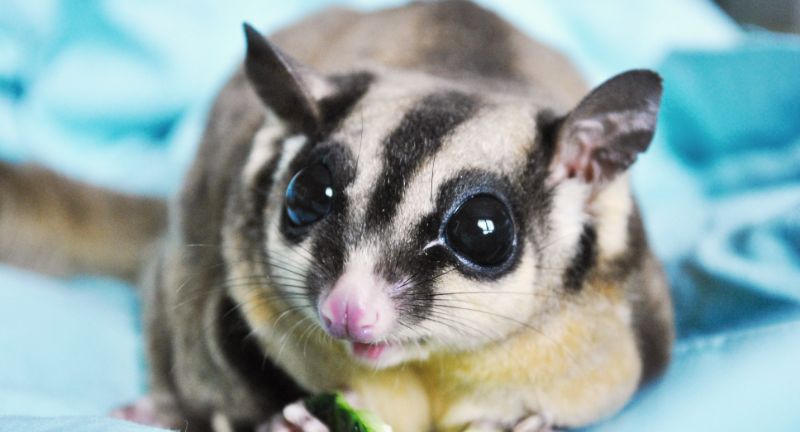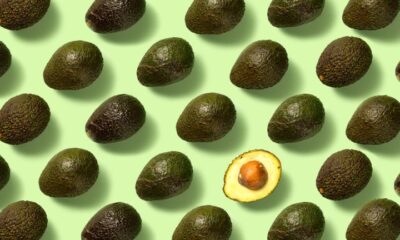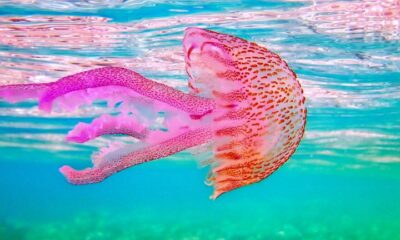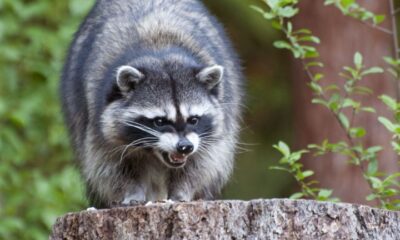NEWS
23 Tiniest Creatures In The World
Published
1 month agoon

Shutterstock
The natural world is full of astonishingly small creatures, many of which are barely visible to the naked eye. These tiny organisms play vital roles in ecosystems, showcasing the incredible diversity of life on Earth. From microscopic insects to minuscule aquatic organisms, each of these creatures demonstrates unique adaptations for survival.
Fairyflies

Shutterstock
Fairyflies, a type of parasitic wasp, are some of the smallest insects in the world. Measuring as little as 0.139 millimeters, they are often smaller than a grain of salt. Despite their tiny size, fairyflies play an essential role in controlling pest populations. Their delicate, almost invisible wings give them a fairy-like appearance, inspiring their whimsical name.
Pea Crabs

Shutterstock
Pea crabs are the smallest crabs in the world, with a body size that can be as tiny as a pea. These fascinating creatures are often found living symbiotically inside the shells of mollusks like oysters and clams. Despite their diminutive size, they are well-adapted to their unique lifestyles. Their relationship with their hosts highlights the intricate interactions in marine ecosystems.
Bee Hummingbird

Shutterstock
The bee hummingbird, native to Cuba, is the smallest bird in the world, measuring just 5-6 centimeters in length. Weighing less than 2 grams, it is often mistaken for an insect. Despite its tiny size, this hummingbird plays a crucial role in pollination, feeding on nectar from flowers. Its iridescent feathers and incredible agility make it a marvel of the avian world.
Thread Snakes

Shutterstock
Thread snakes, such as the Barbados threadsnake, are the smallest snakes in the world, measuring about 10 centimeters long. Found in the Caribbean, these tiny reptiles feed on ants and termites. Their slender bodies allow them to burrow into soil and leaf litter with ease. Despite their small size, thread snakes are perfectly adapted to their subterranean lifestyles.
Tardigrades

Shutterstock
Tardigrades, also known as water bears, are microscopic creatures known for their resilience. Measuring around 0.3 to 0.5 millimeters, they are incredibly tiny but capable of surviving extreme conditions. Tardigrades can endure freezing temperatures, dehydration, and even the vacuum of space. These fascinating creatures are often studied for their unique survival mechanisms.
Pygmy Seahorses

Shutterstock
Pygmy seahorses are some of the smallest marine creatures, measuring about 2 centimeters in length. These tiny seahorses are masters of camouflage, blending perfectly with their coral habitats. Their small size and cryptic appearance help them evade predators. Pygmy seahorses are a favorite among divers and marine biologists for their adorable and elusive nature.
Bumblebee Bats

Shutterstock
The bumblebee bat, also known as Kitti’s hog-nosed bat, is the smallest mammal by weight. Found in limestone caves in Thailand and Myanmar, these bats weigh about 2 grams. Despite their tiny size, they are expert fliers, feeding on insects during their nocturnal hunts. Their small size makes them an important species for studying bat evolution.
Dwarf Goby

Shutterstock
The dwarf goby is one of the smallest fish in the ocean, growing to just over 1 centimeter. Found in coral reefs, these tiny fish play a crucial role in the marine food web. They feed on plankton and serve as prey for larger fish species. Their bright colors and small size make them a favorite subject for underwater photographers.
Speckled Cape Tortoise

Shutterstock
The speckled Cape tortoise, native to South Africa, is the world’s smallest tortoise. Adults rarely grow larger than 10 centimeters in length. This tiny reptile is known for its beautifully patterned shell that helps it blend into its arid environment. Unfortunately, habitat loss has made this species increasingly rare.
Pygmy Jerboa

Shutterstock
The pygmy jerboa is the smallest rodent in the world, with a body length of just 4 to 5 centimeters. Native to the deserts of Central Asia, this tiny creature is known for its long hind legs and remarkable jumping ability. Its small size and agility help it escape predators. Pygmy jerboas feed on seeds and vegetation, playing a key role in their ecosystem.
Miniature Frogs

Shutterstock
Miniature frogs, such as the Paedophryne genus, are some of the smallest amphibians in the world. Found in Papua New Guinea, these frogs measure just 7.7 millimeters in length. Their tiny size allows them to live in leaf litter and avoid predators. Despite their small stature, they are essential for maintaining insect populations in their habitat.
Pygmy Rabbit

Shutterstock
The pygmy rabbit is the world’s smallest rabbit species, weighing less than a pound. Native to North America, they are found in sagebrush habitats where they forage for food. Their small size makes them vulnerable to predators, but their agility and burrowing abilities provide some protection. Pygmy rabbits are an important part of the sagebrush ecosystem.
Etruscan Shrew

Shutterstock
The Etruscan shrew is the smallest mammal by weight, typically less than 2 grams. This tiny creature has a fast metabolism, requiring it to eat twice its body weight daily. Found in Europe, North Africa, and Asia, it preys on insects and small invertebrates. Its small size and rapid movements make it difficult to spot in the wild.
Velvet Worms

Shutterstock
Velvet worms, although small, are fascinating creatures measuring about 1 to 8 centimeters. They are found in tropical forests and have a soft, velvety texture. These predators use adhesive slime to capture their prey. Despite their small size, they are efficient hunters in their ecosystems.
Lesser Short-Nosed Fruit Bat

Shutterstock
The lesser short-nosed fruit bat is one of the smallest fruit bats, with a wingspan of about 10 centimeters. Found in Southeast Asia, these bats feed on fruits and nectar. They play a crucial role in pollination and seed dispersal. Their small size allows them to maneuver easily through dense forests.
Leafhopper Insects

Shutterstock
Leafhoppers are tiny insects, often less than 5 millimeters in size, known for their jumping ability. They feed on plant sap and can be found worldwide. Despite their small size, leafhoppers are incredibly diverse, with thousands of species. They are also an important food source for other insects and birds.
Dwarf Chameleons

Shutterstock
Dwarf chameleons, like Brookesia micra, are some of the smallest reptiles, reaching lengths of just 2.9 centimeters. Native to Madagascar, they thrive in forest environments. Their tiny size allows them to blend seamlessly with leaf litter. Despite their small stature, they exhibit the same color-changing abilities as larger chameleons.
Rotifers

Shutterstock
Rotifers are microscopic aquatic animals that measure between 0.1 to 0.5 millimeters. Found in freshwater environments, they are crucial for nutrient cycling. Their tiny bodies are equipped with a specialized feeding structure that resembles rotating wheels. Rotifers are a critical component of aquatic ecosystems, feeding on detritus and bacteria.
Pygmy Possum

Shutterstock
The pygmy possum is the smallest marsupial, weighing only about 10 grams. Found in Australia, they live in forests and feed on nectar, pollen, and insects. Their tiny size allows them to navigate through dense foliage with ease. These nocturnal creatures are important pollinators for various plant species.
Microbats

Shutterstock
Microbats are a diverse group of small bats that measure just a few centimeters in body length. They are found all over the world and are known for their echolocation abilities. Feeding primarily on insects, they play a significant role in pest control. Their small size allows them to roost in tight spaces like tree hollows and caves.
Nematodes

Shutterstock
Nematodes, or roundworms, are microscopic worms found in nearly every environment on Earth. They are incredibly diverse, with species adapted to live in soil, water, and even within other organisms. Nematodes play essential roles in nutrient cycling and decomposition. Despite their tiny size, they are among the most abundant animals on Earth.
Springtails

Shutterstock
Springtails are tiny arthropods, measuring about 1 to 2 millimeters in length. Found in soil and leaf litter, they play a crucial role in breaking down organic matter. Their name comes from their unique ability to “spring” into the air to escape predators. Despite their small size, they are vital for healthy soil ecosystems.
Micro Jellyfish

Shutterstock
Micro jellyfish, like the Turritopsis dohrnii, are some of the smallest jellyfish species, measuring just a few millimeters. Known as the “immortal jellyfish,” they can revert to a younger stage of development under stress. Found in oceans worldwide, their small size makes them hard to spot. Despite their size, they have captured the attention of scientists studying aging and regeneration.
Conclusion

Shutterstock
The smallest creatures on Earth demonstrate that size is no barrier to survival or ecological importance. From insects and fish to mammals and reptiles, these organisms showcase incredible diversity and adaptability. Each plays a vital role in maintaining the balance of their ecosystems, despite their tiny size. Exploring these miniature marvels reminds us of the beauty and complexity of the natural world.
Related Topics:

More From Lifestylogy
-


LiveGood’s Membership Model Keeps High-Quality Vitamins And Supplements Affordable
-


U.S. Anesthesia Partners Is Solving The Shortage Of Anesthesia Clinicians
-


23 Remedies To Clear Your Sinuses And Breathe Easy Instantly
-


25 Fruits That Last The Longest After Purchase
-


21 Mesmerizing Jellyfish Species Enigmas They Conceal
-


23 Things Adult Men Should Not Be Caught Wearing
-


22 State Laws That Are Hard To Believe They Actually…
-


23 Cars So Reliable Drivers Keep Them for Over A…
-


23 Intriguing Things To Know About Raccoons In America